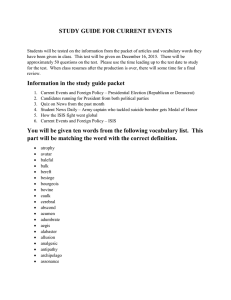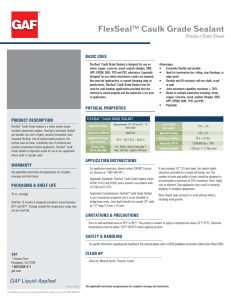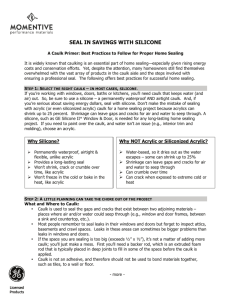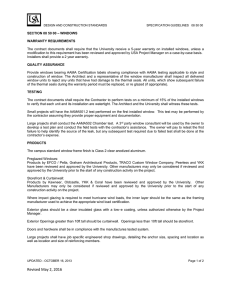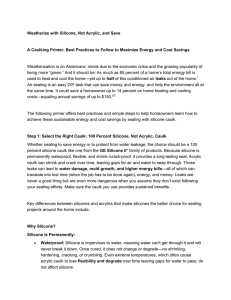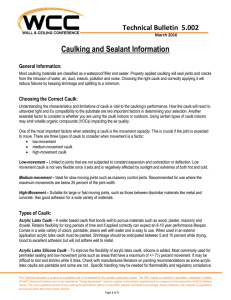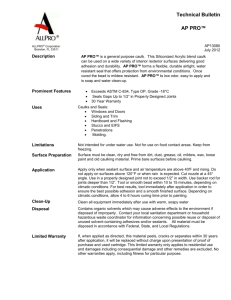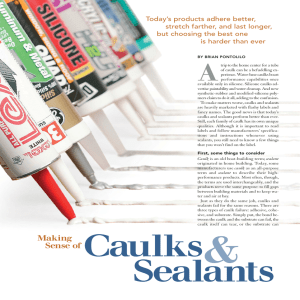The Top 10 Most Common Mistakes of Caulking
advertisement
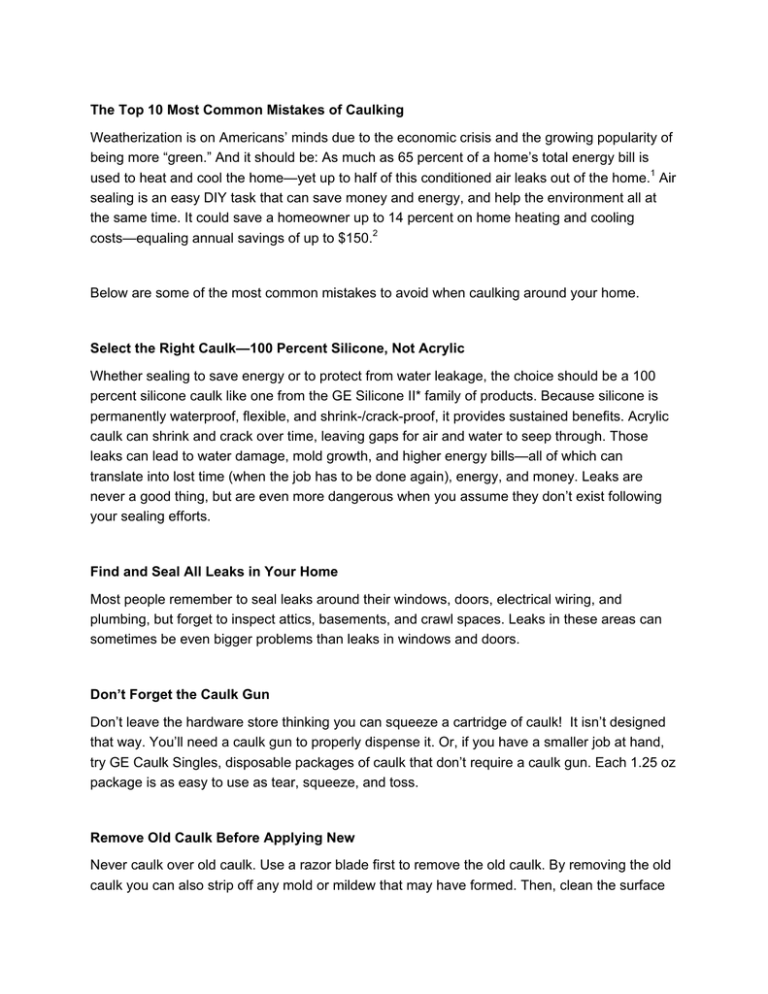
The Top 10 Most Common Mistakes of Caulking Weatherization is on Americans’ minds due to the economic crisis and the growing popularity of being more “green.” And it should be: As much as 65 percent of a home’s total energy bill is used to heat and cool the home—yet up to half of this conditioned air leaks out of the home.1 Air sealing is an easy DIY task that can save money and energy, and help the environment all at the same time. It could save a homeowner up to 14 percent on home heating and cooling costs—equaling annual savings of up to $150.2 Below are some of the most common mistakes to avoid when caulking around your home. Select the Right Caulk—100 Percent Silicone, Not Acrylic Whether sealing to save energy or to protect from water leakage, the choice should be a 100 percent silicone caulk like one from the GE Silicone II* family of products. Because silicone is permanently waterproof, flexible, and shrink-/crack-proof, it provides sustained benefits. Acrylic caulk can shrink and crack over time, leaving gaps for air and water to seep through. Those leaks can lead to water damage, mold growth, and higher energy bills—all of which can translate into lost time (when the job has to be done again), energy, and money. Leaks are never a good thing, but are even more dangerous when you assume they don’t exist following your sealing efforts. Find and Seal All Leaks in Your Home Most people remember to seal leaks around their windows, doors, electrical wiring, and plumbing, but forget to inspect attics, basements, and crawl spaces. Leaks in these areas can sometimes be even bigger problems than leaks in windows and doors. Don’t Forget the Caulk Gun Don’t leave the hardware store thinking you can squeeze a cartridge of caulk! It isn’t designed that way. You’ll need a caulk gun to properly dispense it. Or, if you have a smaller job at hand, try GE Caulk Singles, disposable packages of caulk that don’t require a caulk gun. Each 1.25 oz package is as easy to use as tear, squeeze, and toss. Remove Old Caulk Before Applying New Never caulk over old caulk. Use a razor blade first to remove the old caulk. By removing the old caulk you can also strip off any mold or mildew that may have formed. Then, clean the surface with a household cleaner, rubbing alcohol, or a wire brush, and wipe with a clean cloth. Make sure the surface is clean, dry, and free of soap, grease, dirt, and dust before caulking. Watch Where You Cut the Tube of Caulk With each squeeze of the caulk gun, the line of caulk that is formed is called a bead. A professional-looking bead starts with the right cut. Be careful to cut the opening of the caulk tube to fit the job at hand (e.g., cut near the top for a thin bead and further down for a thick bead). And, for silicone caulk, there is an inner seal that needs to be pierced before you begin. A stiff wire or similar object can be used to break the seal; many caulk guns have such a sharp object attached to the gun. Steady Your Hand and Don’t Press Too Hard to Help Ensure a Smooth Bead Hold the caulk gun at a 45-degree angle. How smooth the caulk dispenses depends on the caulker and the evenness of pressure while squeezing the gun. Avoid “globs” by maintaining an even hand from start to finish. Just a Bead Is All You Need! If the space you are sealing is too big (exceeds 1/2” x 1/2”), it’s not a matter of adding more caulk. First you’ll need a backer rod, which is an extruded foam rod that is typically placed in deep joints to fill in some of the space before the caulk is applied. Even the Best Laid Caulk Requires Tooling Caulking begins with laying the bead of caulk and ends with “tooling,” or smoothing, the caulk. Don’t overlook this important step. Your hands, and in this case a finger, are often the best tools (although you can also buy a smoothing tool if desired). Run your finger along the bead to ensure that it’s neat, even, and most importantly, fills the gap to form a tight seal. Don’t Let Water Wash Away Your Hard Work Some caulk requires up to 24 hours or longer before it can be exposed to water or the caulk will wash away. GE Silicone II Window & Door and GE Silicone II Kitchen & Bath caulk develops strength and adhesion quickly so it can be exposed to water in as little as three hours. For homeowners trying to squeeze home maintenance projects into the weekend, GE Silicone II can decrease the waiting time, helping increase convenience, speed, and efficiency. Don’t Glue… Seal Caulk is used to seal the gaps and cracks that exist between two adjoining materials—places where air and/or water could seep through (e.g., window and door frames, between a sink and countertop, etc.). If you can see daylight through the crack, or feel a draft, seal it with silicone! It is not an adhesive, and therefore should not be used to bond materials together, such as tiles to a wall or floor. For tips on how to caulk and save and additional home sealing information, visit www.caulkandsave.com or email mgray@graycreate.com. ### * Trademark of Momentive Performance Materials Inc. GE is a Registered Trademark of General Electric Company. 1 Energy Information Administration: 2005 Residential Energy Consumption Survey Tables SH5, US5 and AC4 “Residential Ventilation and Energy Characteristics” by Max Sherman and Nance Matson, Energy Performance of Buildings group—Energy and Environment Division at Lawrence Berkeley Laboratory— Supported by the Assistant Secretary for Energy Efficiency and Renewable Energy 2 Assumes: 1) 50 percent of total energy is associated with heating/cooling; 2) 1/3 (33 percent) of heating/cooling costs is associated with all ventilation (includes needed ventilation and excess air infiltration); 3). A homeowner can reduce this ventilation reducing the ventilation energy costs by 30 percent (5 percent savings)—45 percent (8 percent savings); and 4) Average U.S. Home Energy Expenditure (2005 RECS study) for Single Family Detached and Attached Homes is $2,091.
